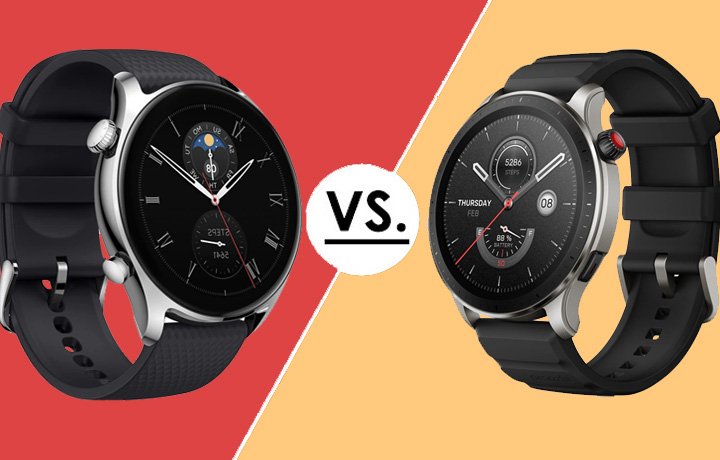Amazfit Balance vs. Amazfit GTR4: Unveiling the Differences
The realm of smartwatches is ever-evolving, with new models offering an array of features to cater to diverse user needs. Among the latest entrants are the Amazfit Balance and Amazfit GTR 4, both vying for the attention of tech-savvy consumers. At first glance, they appear strikingly similar, even sharing a near-identical box. However, delving deeper reveals a myriad of differences that might sway one’s preference.
In this comprehensive comparison, we’ll dissect these two smartwatches, highlighting their distinctions in design, display, functionality, and more. By the end, you’ll be better equipped to make an informed decision about which one suits your lifestyle best. Check out the latest prices: Amazfit GTR4 and Amazfit Balance here.
Design And Build Material:
Upon unboxing, you’ll immediately notice the striking similarity in design between the Amazfit Balance and Amazfit GTR 4. Both feature an alloy aluminum back and are equipped with a rotating crown and a button in precisely matching positions. Even the plastic component at the base exhibits a remarkably close resemblance.
However, a discerning eye will catch the difference in the bezel – the GTR 4 sports a slightly wider bezel compared to the Balance. This variation is consequential, as it allows for a better utilization of screen real estate.
The Amazfit Balance, with its 1.5-inch screen, outpaces the GTR 4’s 1.43-inch display. This results in a higher screen-to-body ratio of 73.4% in the Balance, compared to the GTR 4’s 68%. In essence, the Balance offers a more immersive visual experience.
Display: Brightness and Clarity
Both models boast AMOLED displays, ensuring vivid and sharp visuals. However, a notable distinction lies in brightness levels. The Amazfit Balance shines brighter with an impressive 1500 nits, surpassing the GTR4’s 1000 nits.
This translates to superior readability even in direct sunlight. In terms of pixel density, both watches offer similar figures, though the larger screen of the Balance demands a higher pixel count. This results in equally crisp visuals on both devices.
Battery Life:
The battery performance of these two smartwatches is commendable. Both sport a 475-milliampere nominal value, promising a battery life of up to 14 days under moderate use. Real-world usage, however, tends to bring this figure down to a commendable 9-10 days, a testament to their energy efficiency.
With the Always On display feature activated, both watches still hold their own, with approximately 5 days of usage. In terms of battery life, these models are on par.
Functionality: Beyond the Basics
Here’s where the Amazfit Balance begins to set itself apart. It introduces NFC payments, a feature conspicuously absent in the GTR 4. This addition enhances convenience, allowing users to make secure payments on the go.
Additionally, the Balance offers a readiness index, providing users with a comprehensive morning report on their sleep quality and physical and mental preparedness for the day ahead. This invaluable feature is absent in the GTR 4.
The Balance also takes a leap forward with its body composition measurement, offering insights into muscle mass, fat percentage, bone density, and more. Again, this feature is exclusive to the Balance.
Breathing exercises, a staple in both models, see an enhancement in the Balance with the introduction of focused breathing modes. While the GTR 4 offers the basics, the Balance takes it a step further. The Zepp Aura, a relaxation and sleep quality enhancement feature, is present in both models, but the Balance offers an advantage by providing a 3-month trial, a perk absent in the GTR 4.
Sport enthusiasts will appreciate the Balance’s prediction of race times and its compatibility with triathlon, opening up a whole new realm of possibilities. The GTR 4, while robust, lacks these advanced features.
Operating System: The ZeppOS Factor
The operating system also presents a point of differentiation. The Balance runs on the ZeppOS 3.0, while the GTR 4 remains on ZeppOS 2.0. While an update to the GTR 4’s operating system is anticipated, it remains uncertain. This underscores the Balance’s edge in terms of software advancements.
Sensors: A Heartfelt Improvement
The introduction of the biotracker sensor with evolved heart rate monitoring (version 5.0) in the Balance elevates heart rate measurement precision, particularly during steady-state activities. While both watches provide accurate resting heart rate measurements, the Balance outshines the GTR 4 in dynamic scenarios.
Navigation: A Unified Experience
Both models lack maps for on-the-go navigation, but they do support GPX routes. The Balance, however, doesn’t offer an edge in this aspect.
Pricing: A Considerable Factor
The pricing factor can significantly influence one’s decision. The GTR 4, having been on the market for a year, boasts a more accessible price point, around 220 USD. The newer Balance, with its enhanced features, comes in at a starting price of $229 in the USA. Check out the latest prices here: Amazfit GTR4 and Amazfit Balance.
- More Comparisons Like this:
- Garmin Venu 2 vs. Vivoactive 5: Is Vivoactive 5 better than Venu 2?
- Garmin Vivoactive 5 vs. Samsung Galaxy Watch 6: How To Make The Right Choice
Amazfit Balance vs. Amazfit GTR 4 ”Pros And Cons”:
Amazfit Balance:
-
Pros:
- NFC Payments: The inclusion of NFC payments adds a layer of convenience, allowing for seamless and secure transactions on the go.
- Body Composition Measurement: Offers insights into various body metrics, including muscle mass, fat percentage, and more, providing a comprehensive overview of your health.
- Readiness Index: Provides a morning report on sleep quality and physical and mental preparedness for the day, aiding in optimizing productivity and well-being.
- Focused Breathing Exercises: The addition of focused breathing modes enhances relaxation and stress management capabilities.
- Triathlon Support: Offers compatibility for triathlon enthusiasts, expanding the range of supported sports and activities.
- Zepp Aura with 3-Month Trial: Provides a trial period for Zepp Aura, a feature designed to enhance relaxation and sleep quality.
- Brighter Display: Boasts a higher brightness level of 1500 nits, ensuring excellent visibility even in direct sunlight. Check out the latest price: Amazfit Balance here.
-
Cons:
- Slightly Higher Price: Comes at a starting price of 249 euros, which may be a consideration for budget-conscious buyers.
- Limited Availability of NFC Payments: Availability of NFC payments may vary depending on the region and compatibility with local banking systems.
Reasons to Choose Amazfit Balance:
- Advanced Health Monitoring: Ideal for users seeking comprehensive health and fitness tracking, including body composition measurements and readiness assessments.
- Convenience with NFC Payments: Suited for those who value the convenience of making secure payments directly from their smartwatch.
- Triathlon Enthusiasts: Catering to individuals engaged in triathlon training, offering compatibility for this demanding multi-disciplinary sport. Check out the latest price: Amazfit Balance here.
Amazfit GTR 4:
-
Pros:
- Solid Battery Life: Boasts impressive battery life, offering up to 14 days of usage with moderate use, and around 9-10 days with regular usage.
- Affordable Price: With a more accessible price point (around 200 euros), it provides excellent value for money, especially for its feature set.
- Competent Smartwatch Functions: Offers a range of standard smartwatch features like notifications, heart rate monitoring, and fitness tracking.
- Stable and Proven OS: Runs on ZeppOS 2.0, a stable operating system with proven performance.
-
Cons:
- Slightly Dimmer Display: Boasts a brightness level of 1000 nits, which may result in slightly reduced visibility in direct sunlight compared to the Balance.
- Lacks NFC Payments: Does not support NFC payments, which may be a consideration for users who value this feature.
Reasons to Choose Amazfit GTR 4:
- Budget-Conscious Users: Suited for those seeking a feature-rich smartwatch at a more budget-friendly price point.
- Long Battery Life: Ideal for individuals who prioritize extended battery life, making it suitable for longer periods without recharging.
- Standard Smartwatch Functions: Well-suited for users who primarily require core smartwatch functionalities without advanced health tracking features. Check out the latest price: Amazfit GTR 4.
Final Verdict:
Amazfit Balance is recommended for users looking for an advanced and comprehensive smartwatch experience, with a focus on health and fitness tracking, NFC payments, and triathlon support.
On the other hand, Amazfit GTR 4 offers a solid and affordable smartwatch option with impressive battery life, making it an excellent choice for users seeking a reliable, feature-rich device without the additional health tracking functionalities.
Conclusion:
In conclusion, the Amazfit Balance emerges as the frontrunner, offering an array of advanced features that cater to a diverse range of user needs. From NFC payments to body composition measurements and readiness indices, it provides a comprehensive smartwatch experience.
While the Amazfit GTR4 remains a formidable contender with its commendable battery life and solid functionality, it falls slightly short of the Balance’s extensive feature set. Ultimately, the choice comes down to individual preferences and priorities. Both models excel in their own right, ensuring that no matter the decision, users are poised to experience a high-quality smartwatch experience. Check out the latest prices: Amazfit GTR 4 and Amazfit Balance here.
- Shop On Amazon Using Our Links To Support Us:
- Buy Samsung Galaxy Z Fold 5 – Get your Xiaomi Mix Fold 3 here>>
- Amazon best sellers – Amazon most gifted – Amazon under $25






